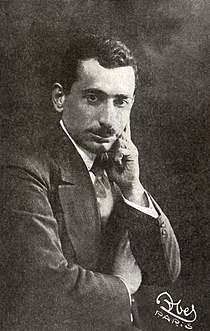Aram Andonian
Aram Andonian (Armenian: Արամ Անտոնեան; 1875 – 23 December 1951) was an ethnic Armenian journalist, historian and writer.
Aram Andonian Արամ Անտոնեան | |
|---|---|
 | |
| Born | 1875 Constantinople, Ottoman Empire |
| Died | December 23, 1951 |
| Nationality | Armenian |
| Occupation | Historian, editor, writer, public figure, drawer |
Biography
Andonian was born in Constantinople. There he edited the Armenian journals Luys (Light) and Dzaghik (Flower) and the newspaper Surhandak (Herald). Andonian then went on to serve in the department of military censorship of the Ottoman Empire.[1] He was arrested by order of interior minister Talat Pasha of the Ottoman Empire on the eve of April 24, 1915, and joined the large number of Armenian notables who were deported from the Ottoman capital. Andonian was deported to Chankiri, then, halfway there, returned to Ankara and was deported again to the camps in the Ra's al-'Ayn and Meskene.[2] However, Andonian survived in Aleppo in the underground.[3] When British forces occupied Aleppo, a lower-level Turkish official, Naim Bey collaborated with Aram Andonian in publishing his memoirs, an account of the deportation of the Armenians.[4] The Memoirs of Naim Bey were published in 1920, and are sometimes referred to as the "Andonian Telegrams" or the "Talat Pasha Telegrams." The telegrams are purported to constitute direct evidence that the Armenian Genocide of 1915–1917 was state policy of the Ottoman Empire. They were introduced as evidence in the trial of Soghomon Tehlirian.[5]
According to Robert Melson, Andonian's report on post-1915 deportations and killings of Armenians are crucial for the research of that period.[6]
From 1928 to 1951 Andonian directed the Nubarian Library in Paris, and succeeded in hiding and saving most of the collection during the German occupation of Paris.
He is the author of a Complete Illustrated History of the Balkan War (Vol. 1–5, 1912–1913), published originally in Armenian.
Works
- «Շիրվանզադէ» (biography of Alexander Shirvanzade), Constantinople, 1911.
- «Պատկերազարդ ընդարձակ պատմութիւն Պալքանեան պատերազմին» (Complete Illustrated History of the Balkan War), 5 vols., Constantinople, 1912-1913 (a Turkish edition came out recently at Aras Yayincilik).
- «Այն սեւ օրերուն» (In Those Dark Days), Boston, 1919.
- «Մեծ Ոճիրը» (The Great Crime), Boston, 1921.
- The Memoirs of Naim Bey, London 1920.
References
- A Crime of Silence: The Armenian Genocide, by Permanent Peoples' Tribunal, Gerard J. Libaridian, 1985, p. 123.
- The Armenian Genocide: Cultural and Ethical Legacies, by Richard G. Hovannisian, Transaction Publishers, 2007, p. 55.
- At the crossroads of Der Zor, by Hilmar Kaiser, Nancy Eskijian, Luther Eskijian - 2002 - p. 93
- The Lions of Marash, by Stanley Elphinstone Kerr - 1973, p. 15
- Dadrian, Vahakn. "The Naim-Andonian Documents on the World War I Destruction of Ottoman Armenians: The Anatomy of a Genocide," International Journal of Middle East Studies, 18 (1986), pp. 311-360.
- Revolution and Genocide: On the Origins of the Armenian Genocide and the Holocaust, By Robert Melson, Contributor Leo Kuper, University of Chicago Press, 1996, ISBN 0-226-51991-0, p. 147
Further reading
- Soulahian-Kuyumjian, Rita. The Survivor: Biography of Aram Andonian. London: Gomidas Institute, June 9, 2010. ISBN 1-903656-94-X.